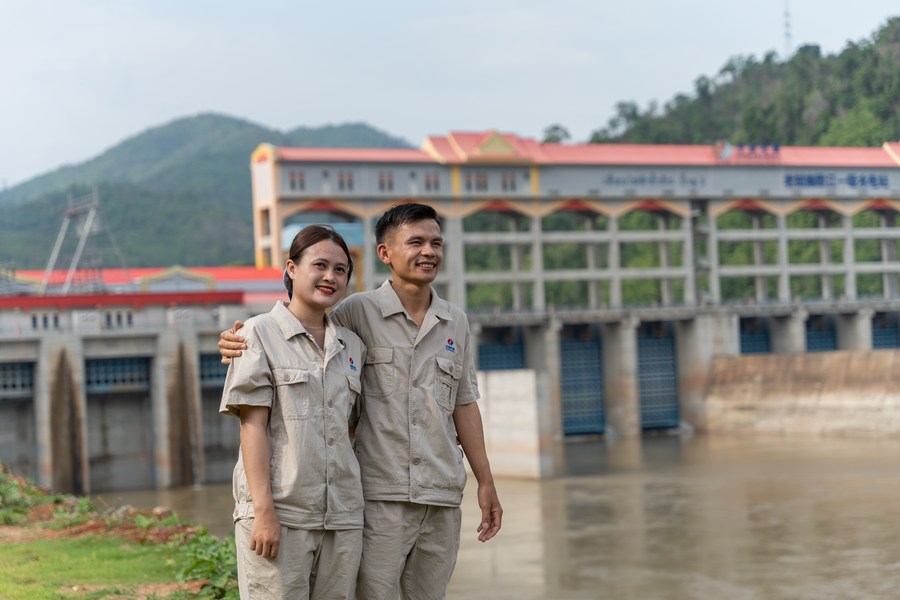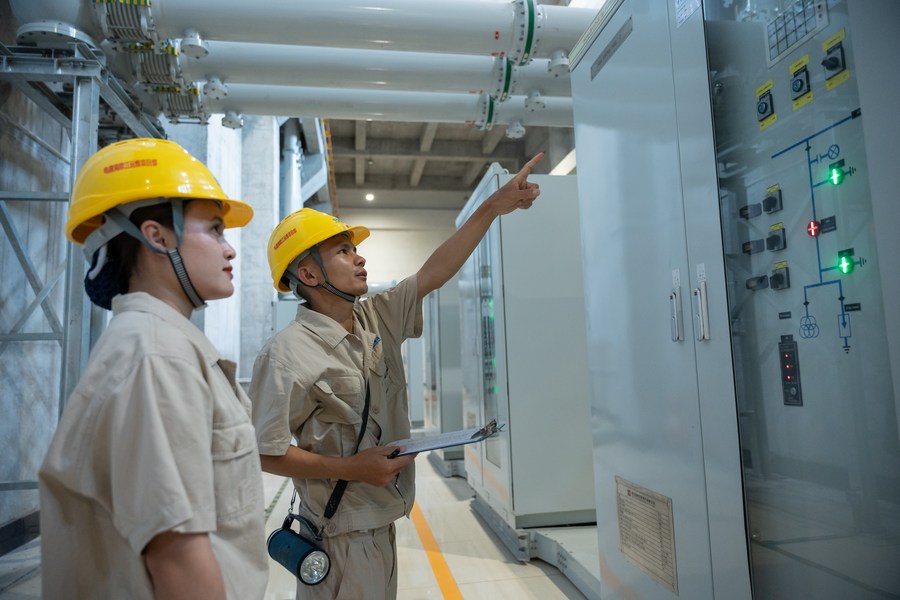Young couple weave dreams, love at Belt and Road project in Laos

Nouphet Thongsakda (R) and Phavady Nalathone pose for photos at the Nam Ou 1 hydropower plant invested by the Power Construction Corporation of China (PowerChina) in Luang Prabang, Laos, on June 16, 2023. (Photo by Kaikeo Saiyasane/Xinhua)
"I would like to express my heartfelt gratitude for all cooperation projects between China and Laos, which allow us to have a better life and become a married couple," said Phavady, a young lady from Xieng Khuang of northern Laos who works at the Nam Ou 1 hydropower plant of the Nam Ou River Cascade Hydropower Project.
VIENTIANE, July 5 (Xinhua) -- Finding a life partner while chasing career dreams is not easy, but a young couple in northern Laos luckily got both when working for the Power Construction Corporation of China (PowerChina).
Since the Belt and Road Initiative (BRI) was proposed by China in 2013, lots of Lao youths have achieved their careers and fulfilled their life dreams by joining the construction and operation of China-Laos cooperation projects over the last decade.
Phavady Nalathone, a 22-year-old young lady from Xieng Khuang of northern Laos, has been working at the Nam Ou 1 hydropower plant of the Nam Ou River Cascade Hydropower Project, which supplies electricity to the China-Laos Railway, in Luang Prabang province since 2020.

Nouphet Thongsakda (R) and Phavady Nalathone carry out daily check at the Nam Ou 1 hydropower plant invested by the Power Construction Corporation of China (PowerChina) in Luang Prabang, Laos, on June 16, 2023. (Photo by Kaikeo Saiyasane/Xinhua)
Phavady told Xinhua that this has been her dream job since she was a kid because she had a childhood memory with a dam and she took her father as a role model.
"My father has been working at the Nam Ngum hydropower 5 plant for over 10 years. I lived and grew up there. I learned and was absorbed about working on the project from real experience while I was staying with my father. Then my family sent me to China to study, and after I came back, my father encouraged me to work with PowerChina," she said.
Phavady went to China to study in business and trade for three years, and after graduation she applied to work with PowerChina, which developed Nam Ou cascade and Nam Ngum 5 projects on respective tributaries of the Mekong River.

Nouphet Thongsakda (L) and Phavady Nalathone walk on the dam of the Nam Ou 1 hydropower plant invested by the Power Construction Corporation of China (PowerChina) in Luang Prabang, Laos, on June 16, 2023. (Photo by Kaikeo Saiyasane/Xinhua)
The Nam Ou River cascade hydropower project, built under the framework of the Belt and Road Initiative, is highly valued by Chinese and Lao governments and peoples.
The project includes seven cascade hydropower plants along the Nam Ou river, the largest tributary of the Mekong river in Laos. The project, put into full operation in September 2021, has a total installed capacity of 1.272 million kilowatts and an average annual generating capacity of 5 billion kilowatt-hours.
"Now I can make a living and support my family. In addition, working with Chinese colleagues helps me improve my Chinese so well," Phavady said.
"I first met him (her husband) when I came to work here. At that time, I had just graduated and my Chinese was more fluent than his. So, whenever we were free we would meet and I've been teaching him Chinese," she said of her love story.
"My friends told me about the project. I heard that the successful applicants will be sent for professional training in China. So, I decided to apply," Nouphet Thongsakda, the 31-year-old husband from Savannakhet province of southern Laos, told Xinhua.
"This opportunity means a lot to me, because I was unemployed and didn't have income for half of the year then. I was very happy to be selected," he said.

Nouphet Thongsakda (L) and Phavady Nalathone have a video chat with their daughter after work in the dormitory of the Nam Ou 1 hydropower plant invested by the Power Construction Corporation of China (PowerChina) in Luang Prabang, Laos, on June 16, 2023. (Photo by Kaikeo Saiyasane/Xinhua)
Nouphet was assigned to work in electrical control room after finishing the training, but he faced communication problems at first.
"Because we have to work closely with Chinese colleagues but I couldn't speak Chinese fluently, it was difficult and challenging. I learned hard until we can communicate better," he said.
"I met her in the office. Her Chinese was better than mine, so I asked her to teach me Chinese and took this chance to know of her. And now we have a cute little baby," he said.
"He is a very good person. He's always kind and ready to learn, and we always support each other," Phavady said.
They told Xinhua that working in the same place gives them the opportunity to be around each other throughout the day, both at home as well as in the office. As a result, they were able to help each other both in work and personal life.
The Nam Ou river cascade hydropower project has generated over 13.3 billion kilowatt-hours of electricity as of June 2023.
The energy and mining sector plays an important role in economic growth. It has delivered numerous benefits in terms of job creation and the construction of roads, schools, hospitals, markets and clean water supplies.
The sale of electricity to neighboring countries and profit yielded from extraction of minerals have earned sizeable amounts of foreign exchange for Laos, which continues to increase.
Electricity represented the largest share of Laos' total exports. For example, in 2022 Laos' exports were valued at 8.19 billion U.S. dollars, with electricity export amounting to 2.35 billion dollars, up 7.5 percent from 2021.

Nouphet Thongsakda (L) and Phavady Nalathone pose for photos at the Nam Ou 1 hydropower plant invested by the Power Construction Corporation of China (PowerChina) in Luang Prabang, Laos, on June 16, 2023. (Photo by Kaikeo Saiyasane/Xinhua)
"First of all, I would like to thank PowerChina for giving me a chance to work here. PowerChina has changed a normal girl like me ever. I have a stable job with a steady income, and found a stable relationship while working here," said Phavady.
"Because of cooperation between Laos and China, we met and fell in love and now we have a lovely daughter as a witness to our love. I would like to express my heartfelt gratitude for all cooperation projects between China and Laos, which allow us to have a better life and become a married couple."
Phavady said the BRI is really a good proposition, especially the China-Laos Railway, to which the Nam Ou project supplies electricity, because Laos is a landlocked country. Since the China-Laos Railway put into operation in December 2021, it makes travelling to neighboring countries more convenient.
"I would like to invite a fresh graduate from abroad or Laos to come and apply for a job with PowerChina and the China-Laos Railway company as well," said Nouphet.
- Pakistani president lauds China as most trustworthy friend
- China's top political advisor meets speaker of lower house of Kazakh parliament
- China, Cambodia to move forward in building high-quality, high-level, high-standard community with shared future
- Chinese-sponsored water, sanitation project launched in Kenya
- China willing to promote Digital Silk Road construction with all parties: senior official

